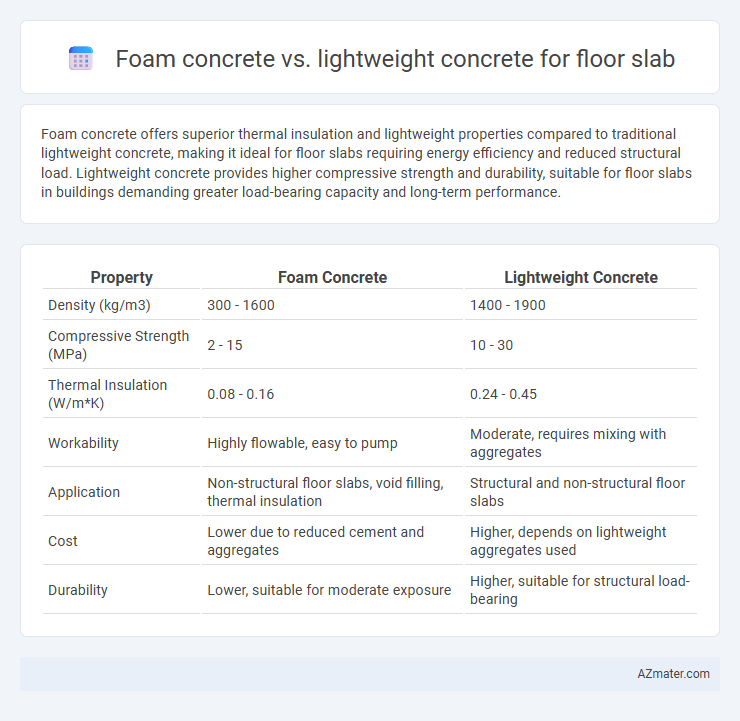Foam concrete offers superior thermal insulation and lightweight properties compared to traditional lightweight concrete, making it ideal for floor slabs requiring energy efficiency and reduced structural load. Lightweight concrete provides higher compressive strength and durability, suitable for floor slabs in buildings demanding greater load-bearing capacity and long-term performance.
Table of Comparison
| Property | Foam Concrete | Lightweight Concrete |
|---|---|---|
| Density (kg/m3) | 300 - 1600 | 1400 - 1900 |
| Compressive Strength (MPa) | 2 - 15 | 10 - 30 |
| Thermal Insulation (W/m*K) | 0.08 - 0.16 | 0.24 - 0.45 |
| Workability | Highly flowable, easy to pump | Moderate, requires mixing with aggregates |
| Application | Non-structural floor slabs, void filling, thermal insulation | Structural and non-structural floor slabs |
| Cost | Lower due to reduced cement and aggregates | Higher, depends on lightweight aggregates used |
| Durability | Lower, suitable for moderate exposure | Higher, suitable for structural load-bearing |
Introduction to Foam Concrete and Lightweight Concrete
Foam concrete consists of cement, water, and foam to create a lightweight material with high air content, making it ideal for thermal insulation and soundproofing in floor slabs. Lightweight concrete, often made by incorporating lightweight aggregates such as expanded clay or shale, offers reduced density and improved structural efficiency while maintaining adequate strength and durability. Both materials provide significant weight reduction compared to conventional concrete, enhancing load distribution and ease of handling in floor slab construction.
Key Material Differences
Foam concrete utilizes a cement slurry mixed with stable air bubbles to create a porous, low-density material ideal for lightweight floor slabs with excellent thermal insulation and sound absorption. Lightweight concrete typically incorporates lightweight aggregates such as expanded clay, shale, or pumice, resulting in higher compressive strength and enhanced durability compared to foam concrete. The primary material difference lies in foam concrete's air-entrained matrix offering superior insulation properties, while lightweight concrete provides a stronger, more structurally stable solution for load-bearing floor slabs.
Structural Properties Comparison
Foam concrete exhibits lower density ranging from 400 to 1600 kg/m3, providing excellent thermal insulation and reduced dead load on floor slabs compared to lightweight concrete, which typically ranges from 1600 to 2000 kg/m3. Structural strength of foam concrete generally falls between 2 to 8 MPa, making it suitable for non-load-bearing applications, whereas lightweight concrete can achieve compressive strengths up to 40 MPa, supporting structural floor slabs. The higher modulus of elasticity in lightweight concrete enhances its load-bearing capacity and resistance to deflection, critical factors for durable floor slab performance.
Weight and Density Considerations
Foam concrete typically has a density ranging from 400 to 1600 kg/m3, making it significantly lighter than traditional lightweight concrete, which usually ranges from 1400 to 1800 kg/m3. The low density of foam concrete reduces the dead load on floor slabs, enhancing structural efficiency and allowing for longer spans or thinner slabs without compromising strength. Weight considerations directly impact foundation design and overall construction costs, with foam concrete offering superior benefits where minimizing weight is critical.
Thermal and Acoustic Insulation Performance
Foam concrete offers superior thermal insulation for floor slabs due to its lower density and high air content, effectively reducing heat transfer and maintaining indoor temperature stability. In terms of acoustic insulation, lightweight concrete provides better sound absorption thanks to its porous aggregate structure, which dissipates sound waves more efficiently than foam concrete. Selecting between foam concrete and lightweight concrete depends on prioritizing thermal efficiency or acoustic performance in floor slab applications.
Installation Process and Workability
Foam concrete offers superior workability due to its flowable consistency, facilitating easier placement and leveling for floor slabs with minimal compaction required. In contrast, lightweight concrete typically demands more careful mixing and compaction to achieve uniform density, often requiring on-site vibration during installation. The installation process for foam concrete is faster and less labor-intensive, making it ideal for complex floor slab geometries and reducing overall construction time.
Cost Analysis and Economic Factors
Foam concrete offers a lower initial material cost compared to lightweight concrete due to its reduced cement consumption and the use of foam agents, making it economically advantageous for large-scale floor slab projects. Lightweight concrete, while generally more expensive upfront, provides superior structural strength and durability, potentially lowering long-term maintenance and repair costs. Analyzing life-cycle costs, foam concrete is ideal for non-load-bearing slabs where budget constraints prioritize immediate savings, whereas lightweight concrete suits applications where performance justifies higher investment.
Durability and Lifespan
Foam concrete offers superior durability for floor slabs due to its closed-cell structure, which provides excellent resistance to moisture infiltration and chemical attack, resulting in a longer lifespan compared to lightweight concrete. Lightweight concrete, while lighter and easier to handle, generally exhibits higher porosity, making it more susceptible to cracking and deterioration under heavy load conditions and aggressive environments. Selecting foam concrete enhances floor slab longevity by minimizing maintenance needs and improving structural integrity over time.
Suitability for Floor Slab Applications
Foam concrete offers excellent thermal insulation and soundproofing properties, making it suitable for floor slabs in residential buildings where energy efficiency is a priority. Lightweight concrete provides higher structural strength and load-bearing capacity, better suited for commercial floors and multi-story buildings requiring durability and reduced dead load. Selecting between foam concrete and lightweight concrete depends on the balance between insulation needs and structural performance for specific floor slab applications.
Summary and Recommendation
Foam concrete offers superior insulation and reduced weight, making it ideal for floor slabs requiring thermal efficiency and ease of installation, while lightweight concrete provides higher compressive strength suitable for structural load-bearing applications. Compared to lightweight concrete, foam concrete has lower density ranging from 400 to 1600 kg/m3 and better sound absorption properties. For floor slabs demanding both strength and insulation, a hybrid approach or tailored mix design based on project-specific load and thermal requirements is recommended.

Infographic: Foam concrete vs Lightweight concrete for Floor slab
 azmater.com
azmater.com